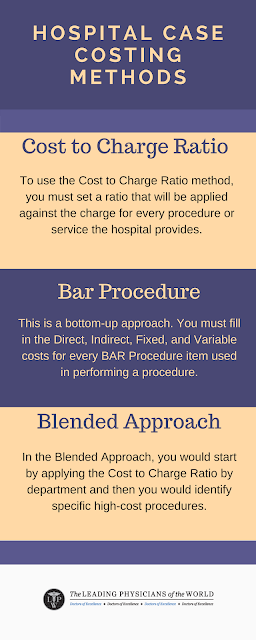Hospital Case Costing Method
Today,
there is a strong media coverage on the increasing cost of health care in the
United States andin many other countries around the world. This gives rise to a
common concern in these countries. So, the question is how best to control the
rate of growth in health care expenditures whilst still delivering good
healthcare. Total health care costs are driven by numerous and complex micro
level decisions by politicians, clinicians and managers. Therefore, macro cost
control can only be achieved through reference to micro level analysis.
Hospitals
have increasingly adopted cost accounting and case mix analysis systems. Activity
cost systems are gaining attention in industrial settings that are
competitively constrained because these systems provide a link between cost
drivers and organizational activities. Although the development of
micro-activity costing seems apparent in the use of diagnostic related groups
(DRGs), cost escalation and the difficulty of making informed decisions remain
unresolved problems. One approach to better understanding and controlling these
trends is the implementation of ‘total cost management’, which relies on an
activity-based costing framework
Here is an
overview of the different costing methods for health care services that have
been used in MCHP research over time.
There are two major sections:
- Costing Methods - this section identifies and describes several sources of expenditure data that are available, the different types of costs that can be included in calculating the total cost of services, and two general approaches to costing health care services.
- Costing Methods for Specific Health Services - this section describes the different MCHP research methods applied to costing specific health care services. Costing methods are described for the following specific health services:
- hospital services
- physician services
- Home Care services
- Personal Care Home (PCH) services
- pharmaceutical/prescription drugs
Healthcare
reforms worldwide have led to an increased reliance on hospital accounting
practices. Accurately estimating the cost of hospital services is of the utmost
importance in the pursuit of efficiency and transparency. Hospitals are
financed through DRG (Diagnosis Related Group)-based prospective payment systems
in most high-income countries. In this context, hospitals have to locate and
eliminate inefficiencies, i.e., services for which the production cost is significantly
higher than the price. Moreover, hospitals need reliable patient-level cost
estimates to measure resource utilization. Accurate and relevant cost
information on hospital services at the patient level is crucial for policy
makers, payers and hospitals.
Allocating
hospital costs to patients involves three steps: the allocation of hospital
overhead costs to departments, the allocation of department overhead costs to
patients, and the allocation of department direct costs to patients. Indeed,
various costing methods are used to allocate department direct costs to
patients, and there is a lack of standardization.
Based on
the significant effect of capital costing methods aforementioned, we have to be
careful while selecting an appropriate method suited to individual context. This is in fact based on economic definition of cost, which
states cost as the value of resources used to produce goods or services.
Therefore, once the resources are used, the cost cannot be considered zero.




Comments
Post a Comment